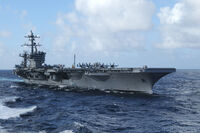
The ANZS Commonwealth, formerly known as the USS Carl Vinson, during a mission in the Southern Hemisphere.
The ANZS Commonwealth (CoCN-01), the world's only remaining nuclear-powered aircraft carrier, is the flagship of the Navy of the Australia-New Zealand Commonwealth. The ship was formerly the USS Carl Vinson (CVN-70), under the command of the United States Navy. It made its way to Australia upon hearing of the Gathering Order in 1984, and was rechristened the ANZS Commonwealth in 1995.
Ship characteristics
- Ship country: Australia-New Zealand Commonwealth
- Hull Number: CoCN-1, previously CVN-70
- Ship ordered: April 5th 1974
- Ship laid down: October 11th, 1975
- Ship launched: March 15th, 1980
- Ship commissioned: March 13th, 1982
- Ship reclassified: 1995
- Ship status: Active service, currently stationed in Mediterranean Sea Malta-Lampedusa-Corridor
- Ship homeport: Brisbane, Australia, ANZC
- Ship motto: Vis per Mare (Strength from the Sea)
- Ship nicknames: Starship Vinson; The Battlestar; The Gold Eagle; San Francisco's Own; America's Favorite Carrier; Chuckie V.; U.S.S. Chuck Wagon; The Carl Prison; Cell Block 70
Specifications
- Class and type: Nimitz-class aircraft carrier
- Length (Waterline): 1,040 meters (317 meters)
- Length (Overall): 1,092 feet (332.84 meters)
- Beam (Waterline): 134 feet (40.84 meters)
- Beam (Overall): 252 feet (76.81 meters)
- Draft: 37 feet - 41 feet (11.28-12.5 meters)
- Displacement: 101,300 long tons (113,500 short tons)
- Crew: 5,680 (3,200 ship's company and 2,480 air crew)
- Propulsion: 2 × Westinghouse A4W nuclear reactors; 4 × steam turbines; 4 × shafts; 260,000 shp (194 MW)
- Range: Unlimited, must be refueled every 20-25 years
- Speed: 30+ knots (55.56+ km/h)
- Sensor Suite:
- AN/SPS-48E 3D Air Search Radar
- AN/SPS-49(V)5 2D Air Search Radar
- AN/SPQ-9 Target Acquisition Radar
- Mk.91 NSSM Guidance System x 4
- Mk.95 Radar x 4
- AN/SPN-41 Landing Aid Radar x 4
- AN/SPN-43C Air Traffic Control Radar
- AN/SPN-46 Air Traffic Control Radar
- Countermeasures:
- AN/SLQ-25A Nixie torpedo countermeasures suite
- AN/SLQ-32(V)4 Electronic Warfare Suite
- Armament:
- 2 x Mk.29 NATO Sea Sparrow Missile Launchers (fires RIM-7 Sea Sparrow missiles)
- 2 x Mk.49 Launchers (fires RIM-116 Rolling Airframe Missiles)
- 3 x 20mm Phalanx CIWS
- Aircraft Carried: 90-100 fixed wing aircraft and helicopters
History
Pre-Doomsday
The USS Carl Vinson CVN-70, the third and newest Nimitz Class nuclear powered aircraft carrier, was on its maiden round-the-world cruise from Norfolk to its new homeport in Alameda, California along with her escorts USS Brumby (FF-1044), the USS Texas (CGN-39), and her embarked Air Wing of ninety-six aircraft. The Vinson Battle Group pulled into Hong Kong’s Victoria Harbor on September 21, 1983 for a 5 day port call.
Doomsday
Urban legend has it that the Vinson was discovered floating freely somewhere in the South Pacific, its crew long dead, killed by some unknown means.
The reality is that the Vinson made it through Doomsday intact, crew and all, and through skill, perseverance and some luck made it to temporary harbor in the Marshall Islands before shocking Allied military forces by showing up in Brisbane harbor for the Gathering Order.
September 26, 1983
More to come...
Post-Doomsday
Japan
Evading the enemy
Guam and the Northern Marianas
Journey to the Marshall Islands
"That radio signal..."
More to come...
Gathering Order
On June 1, 1984, Order 001/1984 was given by the joint ANZUS Head Command set up in Brisbane, Australia, with the approval of the leaders of the U.S., Australia and New Zealand.
This order—today famously referred to as the “Final Gathering” Order—was sent to all reachable U.S. and NATO units.
It ordered all units capable to do so to set course for Australian, New Zealand and Hawaiian territory, otherwise all surviving units in defined geographical area were routed to the nearest suiting gathering point to which ANZUS supply convoys were sent.
At the time, the Vinson was harbored in the Marshall Islands, near the capital of...
More to come...
Into open arms
On xxxx xx, 1985 the Carl Vinson set sail for Brisbane with the cruiser Worden, destroyer Hewitt, and frigates Cook, Barbey and Sides.
On December 8th, the Carl Vinson Battle Group arrived in Brisbane.
A new name
The formal ending of the American Provisional Administration on May 1, 1995 meant that the flagship of the U.S. Navy - along with all other American naval and military assets - now under the command of the Commonwealth.
For the Vinson, that not only meant the completion of the transitionary period from U.S. to ANZC command, it also meant a new name, and new identity.
On July 4, 1995 in a ceremony at Darwin, Australia, the USS Carl Vinson (CVN-70) was rechristened the ANZS Commonwealth (CoCN-1), becoming the flagship of the new Commonwealth's Navy.
The ceremony sparked public debate over the propriety of having a nuclear-powered carrier in the Commonwealth Navy, particularly in light of the nuclear war that had threatened to destroy all of humanity 12 years before. Those concerns were gently, but firmly, answered by ANZC military and political leaders with the following points:
- The Vinson/Commonwealth was too important of a military asset to simply dismantle
- The continuing global situation made it necessary for the Commonwealth to be able to defend itself and its allies. Dismantling the ANZS Commonwealth would put the alliance at risk
- The ship's nuclear-powered engines were more cost-efficient, long-term, to maintain than reverting back to pre-nuclear technology
The 2004 "Census" Mission
More to come
Sicilian Crisis
More to come
| ||||||||||||||||||||||

